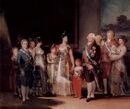
| ||||||||||||||||||
| Total population | ||||||||||||||||||
|---|---|---|---|---|---|---|---|---|---|---|---|---|---|---|---|---|---|---|
Hundreds of millions of Latin Americans with Spanish ancestry (mestizo/criollo) | ||||||||||||||||||
| Regions with significant populations | ||||||||||||||||||
| ||||||||||||||||||
| Languages | ||||||||||||||||||
|
Languages of Spain | ||||||||||||||||||
| Religion | ||||||||||||||||||
|
| ||||||||||||||||||
| Related ethnic groups | ||||||||||||||||||
|
Portuguese people, French people, Italians, other Western Europeans, Sephardic Jews |
The Spanish people or the Spaniards (Spanish: Los Pueblos Españoles) are a Latinic-speaking nation from Spain, in the eastern Iberian Peninsula, or those descended from and associate themselves with Spain, as the country is multi-ethnic and each ethnicity displaying its own sense of local cultural pride and idetntiy.
The development of a Spanish culture originated in the Roman province of Hispania, which covers what is today Spain, and the various Spanish languages within the modern-day country were a result of the vernacular of Vulgar Latin introduced by Roman soldiers. From 711 to 1492, the Iberian Peninsula was under Islamic control, and the population Islamized until the Reconquista which defeated the Muslims, and the Inquisition which saw their deportation, with the last having been deported after the failed Morisco revolt.
After the Reconquista, the Spaniards embarked on a vigorous global domination and Catholicization campaign, and from the time period between 1492 to the late 1800s, had successfully established one of the world's largest empires, rivaled only in size and power by the British Empire. As a result, the global Spanish domination also led to the widescale-spread of Roman Catholicism, which is now the world's largest Christian church, with 1.3 billion practitioners.
During the various revolutions that marked the end of the Empire, many elite familes, of the nobility or gentry of pure Spanish ethnicity associated themselves with their respective new nations, therefore often-not, no longer considered Spaniards.
Etymology[]
The term Spanish and Spain originate from the ancient Roman name for the Iberian Peninsula - Hispania, which includes both modern-day Spain and Portugal. The name Hispania still has its modern-day variants. Spain is still called España in the Spanish language(s) and Espanha in the Portuguese language, which is equivalent to Hispania in Latin, let alone that both languages are Latinic descendants. The Spanish language comes from the Castile region in Spain, the language is referred to as the Castilian language. The term Castilian comes from the Spanish/Castilian word castillo which means castle in English.
History[]
Early History[]
The Iberian Peninsula was inhabited by modern humans some 40,000 years ago. Spanish people are descended several groups. The ancient ethnic group known as the Iberians, are assumedly the earliest civilization to have developed in the peninsula, bound together by a common language and culture. In 2,000 B.C., Celtic tribes began to settle into what is now northern Spain and Portugal. Many came into contact with the Iberians and intermingled. Arabs and Berbers populated the southern part of the peninsula upon the Muslim conquest of the Iberian Peninsula.
Roman Annexation[]
To the east, was the powerful Roman Empire that had spent much time extending its borders. The Carthaginians, a Phoenician civilization from North Africa were one of the only kingdoms that could stand against this mighty military
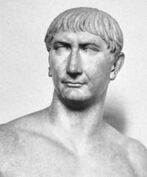
Trajan
power. Hannibal, the leader of the rivaling Carthaginian Empire, crossed into the Iberian Peninsula and made contact with the civilizations there. Hannibal was able to convince many of the Iberian natives to help him in his war cause against Rome. Despite giving the Romans a blow, the Carthaginians lost the war. Around 2 and 1 B.C., Spain was conquered and colonized by the Romans. The Romans introduced the Latin language to the native people of Hispania, which quickly became the native tongues of most, except for the Basque people. The Romans named the Iberian Peninsula Hispania, which became an important state in Rome. In 98 A.D., the Roman Empire became ruled by a native from Hispania by the name of Trajan, who became a very influential leader in ancient Roman politics. Trajan is known for having reshaped the city of Rome, he used public funds to build large structures in the city. Trajan also lead the Romans to many military victories which leading the republic to the height of its extent. Trajan's reign would play an everlasting legacy in Roman history. He also extended the borders of the Roman Empire when he conquered the Nabataeans, an Arab kingdom from what is now Jordan and Syria. Trajan was succeeded by another native from Hispania by the name of Hadrian. Like Trajan, Hadrian spent money on extensive building projects in Rome. In 409 A.D., other tribes settled in the Iberian Peninsula.
Germanic Tribes Rule Iberian Peninsula[]
In 406 A.D., the Roman Empire's western defenses crumbled as a result of the aging and withering of the western Roman Empire. Germanic tribes, such as the Vandals seized this opportunity to invade the Roman Empire through vicious pillaging. However, they were met another savage Germanic group known as Visigoths, who pushed them into Spain. In Spain, the Vandals fought both Romans and Visigoths, winning the control of a few coastal settlements.[8] The Visigoths, an ally of the Romans would later conquer the Iberian Peninsula and established a state there. Other Germanic tribes that settled in the Peninsula included the Sueves an the Alani.[9]
Medieval Kingdoms in the Iberian Peninsula[]
During the Middle Ages, Iberia was ruled by several kingdoms, many of them containing monarchs of Visigoth dynasty mostly from the Visigoth Asturias. These kingdoms coincided with the Muslim rule in Iberia (see below). In 910, the Visigoths moved the capital from Asturias to the city of León under the rule of Ordoño II who inherited the throne from his father with his two brothers. This new kingdom would span the northwestern part of the Iberian Peninsula, covering northwestern Spain and Portugal. The Kingdom of León (910–1230) retained an independent status from 1296 to 1301 and after it reunited with the Castilian kingdom (another Latinic medieval kingdom), it became kingdom within a united Spain up to 1833. On November 1833, the Royal Decree of 30 was signed which monitored the borders of regions and states in Spain. León was considered was divided into the provinces of Salamanca, León and Zamora.[10] The Kingdom of Aragon (1035–1715) covered the region directly south of France. An independent state would emerge in the region of Castile, which got its name due to the high amount of castles in the area. The term castile is Spanish for castle. The Kingdom of Castile (Spanish: Reino de Castilla', Latin: Regnum Castellae) which lasted from 1037 to 1230 - which had high connections with León. When Castile and León was ruled by Ferdinand III, the Castilians would plan to take southern Spain from the Muslims (see Reconquista below). Both kingdoms would unite under the Crown of Castile, which would rule several regions in Spain. In 1474, Isabella I, a husband of the Aragonese ruler Ferdinand II, became the queen of Castile and León who united the peoples of Spain and brought many reforms to the kingdom. She and her husband were also known for finally retaking the Iberian Peninsula from the Muslims. During that same year, Ferdinand II became the jure uxoris king of Castile. These Castilian rulers belonged to a dynasty known as the House of Bourbon, a European dynasty of French origin that ruled over Latinic and Germanic nations in Europe.
Muslim Rule []
In 711 AD, Umayyad Muslim armies from North Africa and the Middle East, referred to by the Europeans as Moors, attacked the weakened Visigoth Kingdom under the lead of Tariq ibn Ziyad, a Berber (Arab or Persian according to some sources) general
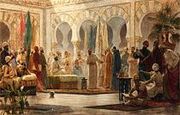
"Abd-ar-Rahman III and his court in Medina Azahara", by Dionisio Baixeras Verdaguer.
from North Africa. The Visigoths were easily defeated, allowing the Muslims to control nearly all of Iberia. The only non-Muslim regions were the Christian settlements in the north near France who resisted the Muslim rule, especially the Leonese and Castilian kingdoms. The Muslim-controlled regions of the Iberian Peninsula were known as Al-Andalus.
Muslim and Jewish Golden Age []

Interior view of the Aljafería Palace in Zaragoza, Spain built by the Taifas - independent Muslim states
Abd-ar-Rahman III (Arabic: عبد الرحمن الثالث), an Umayyad-Spanish prince led the most powerful rule from Córdoba, ruling as a caliph (leader of Islam) for ever half a century. Under Abd-ar-Rahman III's reign, people of many religions enjoyed tolerance in his kingdom. Many of the Iberian natives were converted to Islam and underwent a large period of Muslim rule that varied between the ethnic groups from North Africa such as Arabs and Berbers and Muslim kingdoms from the Umayyads to the Berber Almohads and Almoravids. The Muslim rule in Spain saw the construction of beautiful mosques and palaces, such as the Alhambra Palace which was built in the city of Granada, then, a kingdom and later a sultanate, which is a Muslim kingdom ruled by a sultan (Arabic: سلطان), an Indo-Islamic term for a Muslim ruler. The Muslim conquest of Spain was part of the centuries-long tenure of armed struggle between Muslim and European Christian armies known as the Crusades. Jews also had a large, important and noticeable presence in Spain during the Muslim rule, who were known as Sephardic Jews (Hebrew: סְפָרַדִּי, Spanish: Judios sefardí) and they were known to welcome the Muslim invaders.[11] Moses ben Maimon (Hebrew: משה בן מימון, Arabic: موسى بن ميمون), better known by his Latinized named Maimonides is one of the most popular Sephardic Medieval figures and philosaphers who was from Córdoba during the Almoravid rule. These Sephardic Jews in Spain adopted a culture that contained a fushion of Jewish, Arab and Spanish influence heralding an golden age of Jewish culture in Spain that coincided with the Muslim golden age. A lot of the Jews and Christians in Spain also adopted Arabic naming customs during the Muslim rule. The Christians who lived in Al-Andalus were known as Mozarabs (Spanish: mozárabes, Arabic: مستعرب) and they spoke a fusion of Italic languages with Arabic known as Mozarabic.
The Reconquista
Disputes and civil wars between successors and heirs to thrones began to weaken the Muslim rule and cause derision, setting the stage for the Reconquista - the area of the Crusades fought in the Iberian Peninsula. The Christian settlements in the north used the fighting as an oppurtunity to
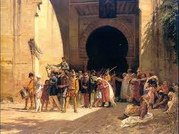
An artist's rendering of the Morisco expulsion
regain control of Iberia and re-Christianize the Iberian natives. They also recieved aid from France, Italy and other former Roman states and devout Catholic states. The Muslim rule was driven out from Spain and Portugal in 1492. Many of the Castilian military leaders adopted Arabic words, Muhammad XII, the last sultan in Al-Andalus, surrendered upon surrounding by European armies after Granada was successfuly taken by Spanish Christian armies. Philip II of Spain made treaties with the Moors of Spain allowing them continue practicing Islam if they gave up their sovereignty, signing the Treaty of Granada in 1491 signed in the former sultanate. He later abrogated the treaty and along with other Catholic monarchs - Ferdinand II of Aragon and Isabela I of Castile, threatened to expel or even kill the Moors and the Sephardis if they did not convert to Christianity. They converted to Catholicism but continued practicing Muslim culture, they continued speaking Arabic and Berber and writing Spanish texts in the Arabic script and wore Muslim attire, they were known as

Ferdinand the Catholic, by the "Meister der Magdalenen-Legende
Moriscos. The overall converts to Christianity, whether Muslim or Jewish were known as conversos. Many of these people even practiced Crypto-Islam (Islam in secret) or Crypto-Judaism while displaying themselves as Catholics in public. This made King Phillip II to question their honesty as converts, and them began a pogrom to eliminate Arab and Moorish culture in Spain and assimilate the Moriscos and Jews into the Spanish Christian population. The Moriscos were forced to drop their Arabic names and adopt Spanish names, they were also forebidden from speaking Arabic either at home or in the public. All Arabic and Hebrew texts were also to be burned and Morisco and Sephardi children were to be educated by priests. Aben Humeya, Spanish military commander led a Morisco revolt in the Alpujarras region near Granada which ended up in a failure making Philip II expel all Moriscos and Sephardis from Spain altogether. The expulsion of the Moriscos marked the downfall of the last hints of Islam and its influence in Spain. Many of these Moriscos and Sephardis headed for North Africa, mainly in Morocco which later became a protectorate of the short-lived Spanish Republic.
Spanish Empire[]
The 1400s became an era marked by a European thirst for territory in Asia, through a westward route. Many of the Protestant and Germanic states like Britain and the Dutch Empire limited their ambitions to economic trade - to get access to precious metals and raw materials. However, Spain also
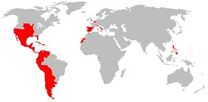
Spanish Empire at its greatest extent
had big religious ambitions to convert natives to Roman Catholicism, creating a competition and a race between the European powers. Christopher Columbus, an Italian explorer, was funded by Ferdinand V and Queen Isabella I, both Spanish monarchs to find a westward route to Asia. Columbus did find lands, however instead of finding Asia, he discovered what man would one day call America. Following Columbus's discovery of America, Amerigo Vespucci re-explored where Columbus left off. Vespucci arrived in what is now Brazil and other parts of South America and claimed it for Portugal. Spain started to use conquistadors, soldiers and
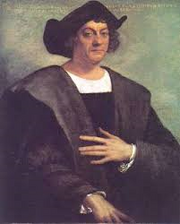
Christopher Columbus
explorers, to claim lands for Spain (and Portugal). A conquistador named Juan Ponce de León led the first expedition. He tried to search for a mythological land referred to as the "Fountain of Youth", he discovered Florida, but became the governor of Puerto Rico. In 1513, a man named Vasco Núñez de Balboa became the first conquistador to reach the Pacific Ocean. He did so by crossing the Isthmus of Panama, which connected Central and South America. The Spanish monarchs finally got what they wanted when they sent a conquistador by the name of Hernán Cortés to venture out. Cortés discovered what is now Mexico and found exactly what any European monarch dreamed of, cities filled with gold, silver, new crops and non-Catholics to convert. He encountered the native people, mostly from the Nahautl tribe; who first treated him as a god. Cortés eventually met native resistance, and easily crushed the native kingdoms whose stone weapons had no match against him and the steel Spanish weapons in 1519. Cortés converted all of the natives to Roman Catholicism, claiming and governing Mexico for the Spanish Crown. In South America, another Spanish conquistador by the name of Francisco Pizarro made his claims for Spain in 1524. Like Cortés, Pizarro defeated the native armies of the region and doubled the size of the Spanish Empire. In 1521, Ferdinand Magellan, a Portuguese conquistador who worked for Spain discovered the Philippines instead of finding Indonesia. Miguel López de Legazpi, a Spanish conquistador followed. In in the central Philippine island of Visayas, Legazpi was able to lure the natives into converting to

Hernán Cortés
Roman Catholicism. Legazpi eventually took over most of the Philippines, becoming the first conquistador to set up a Spanish settlement in the Pacific. The Spanish had just conquered the world's second largest empire, after the British, enjoying vast amounts of wealth, Catholic converts, and new crops from what Europeans referred to as the "New World". The Spanish enjoyment came at the cost of millions of native causalities, both intentional and non-intentional, until Bartolomé de las Casas; a Spanish priest fought and protested against the inhumane treatment. After nearly 300 years of wealthy success, Spain's power began to experience a rapid decline as the mid and late-1800s approached, an era filled with revolutions and a war with France. In Mexico, the priest known by Miguel Hidalgo started the avalanche that would become the Mexican Revolution, in South America, a military leader, Simón Bolívar from Venezuela started Latin America's independence struggle against Spain. In the Philippines, two scholars, authors and polymaths by the names of Andrés Bonifacio and José Rizal led a literary resistance against Spain, that would also trigger the Philippine Revolution. Despite being executed, the revolutions that resulted from Hidalgo and Rizal's resistances succeeded. Bolívar's revolution also succeeded decisively.
Napoleonic Wars (Peninsular War) 1808-1814[]
When the French military leader Napoleon Bonaparte siezed power in the French government, he often led out successful military campaigns against other European armies, namely Austria, Spain and Russia. The Spanish and Portuguese armies were one of the armies that consisted of the Coalition, a band of European even Asian armies such as the Ottomans who joined together to put down the French juggernaut. Bonaparte's armies would conduct conquest in all sorts of places, including Spain, Russia, Egypt and Austria where he but his family members in control after conquering these places.[12] In 1807, French armies invaded Portugal and turned to Spain the following the year after he signed a pact with Russia. On November 30, 1807 the Portuguese nobility fled to Brazil after General Andoche Junot led a force of 30,000 French troops to invade it. Spain's prime minister, Godoy urged Charles IV, the king of Spain to flee to South America as had Portugal's monarchs due to the impending French invasion. During his exit from Madrid, he was met with a rebellion in Aranjuez, where Napoleon decided to take advantage. General Joachim Murat was sent to occupy Madrid and on May 5, 1808 Napoleon forced to Charles IV to abdicate, Joseph Bonaparte, a brother of Napoleon wa placed on the Spanish throne. Spanish resistance against the French occupation had begun on May 2, 1808 starting Spain's independance war against Napoleon. Despite putting down the revolt, the French armies dealt with constant harrassment and attacks from Spanish guerillias. They Spanish guerillias drove French forces from Valencia. In 1809-1810, the French armies did manage to conduct successful recapturing of Madrid and Seville. Spanish guerillia attacks continued. British armies drove the French out of Portugal as well. Under the lead of Arthur Wellesley (later the Duke of Wellington), Napoleon's British arch rival the British armies would begin to advance to Spain after defeating the French forces in Portugal. British forces defeated General Jean-Baptiste Jourdan's army in the Spanish city of Vitoria on June 21, 1813. After brutally losing another battle in the city of Leipzig (in the modern-day Germany), Napoleon realized that he could no longer attempt to hold his occupation of Spain any longer marking the Spanish and Allied victory as well as the latter adoption of a Spanish constitution. Joseph Bonaparte abdicated the throne afterwards.
First Republic 1873-1874[]
In 1870, the Spanish Empire came under the rule of an Italian prince by the name of Amadeo I after a revolt against Isabella II. The Spanish Parliment, known as the Cortes Generales, fell victim to fighting between its own members which led to Amadeo I's abdication of the throne in 1873. A day later, the Cortes Generales decided that Spain would become a republic, unsure of what type of government should be established. In 1874, Madrid's Captal General, Manuel Pavia led forces in support of a unitary republic. On December 29, 1874, the republican forces decided not to stand against supporerters of the Bourbon dynasty which resulted in the collapse of the first republic and Spain's restoration into a monarchy under a Bourbon ruler.[13]
Spanish-American War 1898[]
By the time the Central and South American colonies gained their independence, the Spanish Empire had shrunk from about a third of the world, to nothing more than Spain, Cuba, Puerto Rico and the Philippines. These were nothing more than a group of islands in the Caribbean and Pacific and a hunk of land in the Iberian Peninsula. The United States was just dawning its as a world military power, and did so by strengthening its navy. The Cuban and Filipino struggles for independence fueled American support to intervene and provide support for revolutionaries. Following the destruction of an unarmed United States warship in Havana Bay, the Americans and Spaniards went to battle in 1898. American naval forces blockaded the entire Caribbean region, forcing the Spanish soldiers and naval forces into submission. In the Philippines, the Spanish forces also surrendered Manila Bay to the Americans which resulted in a quick and decisive U.S. victory. At last, Spain, that once mighty and vast empire, was pushed back to where it started - nothing more than a hunk of land in the eastern Iberian Peninsula.
Second Republic 1931-1939[]
In 1929, a great economic crash in the United States devastated many European nations. On January 29, 1930, Miguel Primo de Rivera, Spain's dictatorial military leader was overthrown as a result of the economic effects that the depression. Alfonso XIII, Spain's king at the time supported Primo de Rivera's regime but when the Pact of San Sebastián was signed by republican leaders Miguel Maura and Niceto Alcalá-Zamora which was a plan to overthrow the monarch. Alfonso XIII abdicated the throne, and self-exiled himself to Rome. Niceto Alcalá-Zamora was elected as Spain's first president. Under his presidency, Spain adopted a new constitution that guaranteed freedom of speech and of other matters such as divorce and opened voting to women. It also lessened the rights and powers of Spanish nobilities. On 1936, General Francisco Franco, a pro-monarchist leader led a civil war in which he emerged victorious which led to the expulsion of the Spanish Republic to Mexico City that coincided with Mexico's war for independence.[14]
Spanish Civil War 1936-1939[]
Francisco Franco led the Nationalists, in support of the restoring of the House of Bourbon to rule over Spain and the

Republican forces on tanks during the Battle of Belchite
Republican forces. Franco led a failed military coup in 1936. Since both armies shared pessimistic views, they turned to other military powers for aid. The Nationalists were supported by Nazi Germany and Fascist Italy while the Soviet Union and Mexico provided aid for the Republicans. It also allowed Nazi Germany and the Soviet Union to use the Spain to test their military capabilities. The Republicans were unable to stop the Nationalists and were pockets retreated into France. A battle between communists and anti-communists also broke out in Madrid on March 7, 1939. On March 28, the Republican forces met much disarray as the Nationalists took Madrid sealing a victory for Franco. The civil war had been characterized by brutal assassinations, executions and massacring of towns.[15]
Religion[]
Roman Catholicism and Christianity[]

Cathedral of Santiago de Compostela
Having been a colony of the Roman Republic and the "Holy" Roman Empire, almost all of the majority of Spanish people or Spanish-descended people are overwhelmingly adherents to Christianity, the Roman Catholic Church. Roman Catholicism has been the state religion of Spain for centuries, and has played a dominant role in Spanish culture both in Spain and the Latin American countries.
Religious districts in Spain follow Latin influence and bear similarity to the churches of France and Italy. Of course, Christian preachers are known a priests. Spain's churches are organized into religious districts known as a diocese governed by bishops and divided into parishes. An even more prestigious rank would be an archdiocese and archbishop. The seat of a bishop is known as a see or an Episcopal see.
During the Imperial Age, Spain's monarchs were all Catholics as required by law. During the Imperial Age, being Catholic was required to venture with the Spanish colonists to the New World, many non-Catholics had to convert from their former faiths in order to travel with the Spaniards to the New World. Spain converted all of the people of their conquered territories to Roman Catholicism, or at least attempted to, and the Spanish colonists are responsible for making Roman Catholicism one of the world's most practiced religions.
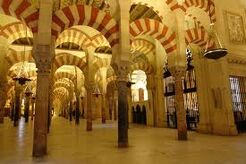
The former prayer hall inside the Mosque–Cathedral of Córdoba, a medieval Moorish mosque that is now a Christian cathedral
The the native rulers of the territories that Spain conquered were allowed to keep the royal traditions and privileges that they had enjoyed if they converted to Roman Catholicism. They were given a prestigious Spanish education and their descendants make up some of the politicians of former Spanish colonies such as Mexico and the Philippines.
There was also a section of the Roman Catholic Church known as the Society of Jesus (Latin: Societas Iesu) whos followers were known as Jesuits that operated in Spain which was found by Ignatius of Loyola, a Basque missionary. In 1767, the Jesuits were expelled from Spain and other European nations which led to their struggle.
Spain is one of the many European countries of the west that is popular for its cathedrals and churches. In the post-Reconquista era, rather than destroying the medieval mosques and palaces built by the Moors, the Spanish Christian monarchs decided to preserve and convert them to Roman Catholic churches rather than destroying them, a contrary of King Philip II's pogrom to eliminate Moorish and Islamic influence from Spain.
Judaism and Islam[]
There have been many attempts by Muslim activist groups in Spain to revert Andalucia's former mosques (now churches) back into mosques or at least to be allowed to pray in these former mosques, but they have all failed and have been rejected by religious authorities in Spain.[16][17] Most of Spain's Muslims today are foreigners or of foreign origin.
The history of Judaism in Spain coincides with Islam's history in Spain. Some groups of Jews did emigrate back to Spain, and many of their descendants (Sephardis) live in North Africa, Israel or Latin America.
Language[]
The peoples of Spain speak a variety of Italic (also called Latin Romance or Latinic) languages that are native to the Iberian Peninsula consisting of regional dialects. Out of these, the Castilian dialect is the most spoken, which eventually became the world major language we come to know today as Spanish. The Castilian language is Spain's national language. Other languages native to Spain include Catalan, Galician and Basque. Catalan and Galician are related Italic languages to Castilian. Like Castilian, Galician also evolved into a major language which we would come to know as Portuguese and became Portugal and Brazil's national languages. The Basque language is not related to the Italic languages, despite being native to the borders and land within Spain. The Basque people are descendants of Europe's earliest settlers, who are theorized to be related to the ancient Iberians. The Basque language and ethnic group are unrelated to Castilian (Spanish), Catalan, Galician (Portuguese) or any of the other Italic Romance languages and people. In fact, Basque is not related to any Indo-European language or ethnic group at all. Basque is considered an isolate language and is also spoken in southwestern France since the Basque linguistic region also spans that area. The Basques have separated themselves from the mainstream cultures of Spain and France and even declared independence from both countries. The standard Spanish language is the third most-spoken language in the entire world behind English and Chinese. It is the dominant language spoken in Central America and South America, and gaining a large number of speakers in the United States.
Art and Architecture[]
Art[]
Spanish art is most famous for the impacting historic works of painters Pablo Picasso, Salvador Dalí and Francisco Goya. Picasso is known for having helped pioneer the art of constructed sculptures and the collage. Picasso is renowned by artists worldwide as the most influential in the twentieth-century. Modern-day Spanish art is dominated by religion, portraying saints and religious figures. Goya's artwork usually reflected the noble ruling class of Spain. Dalí's work focuses on the art of surrealism. In 1931, Dalí painted what would become one of the art world's most popular paintings, The Persistence of Memory. He was known for making surrealistic paintings from his perception of time.
Architecture[]
Spanish architecture is of the ancient Roman, Visigoth and Arab influence. Spain is home to a lot of famous churches a
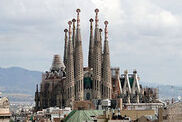
Sagrada Familia
nd cathedrals as well as ancient Roman aqueducts. These aqueducts still function and carry water throughout Spanish cities! Many of the cathedrals in southern Spain, known as Andalusia (from the Arabic name Al-Andalus) were once mosques built by the Muslim Moors. The Sagrada Familia Cathedral located in Barcelona, Spain is destined to be one of the world's largest cathedrals. The Sagrada Familia is still under construction and has been under construction since the late 1800s still to be a modern marvel. In the late 1800s, the world experienced a period which saw appreciation for Arab and Berber architecture. Spain was one of the countries to undergo what would become the Moorish Revival in which many churches and recreational buildings were built upon Moorish influence.
Ancient Roman Architecture[]
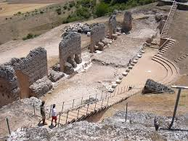
Ancient Roman city of Clunia
Architecture has flourished in Spain ever since Roman rule, along with the reign of Roman emperor Trajan who was a native of Spain. The villa was a country-house where the upper classes, known as the Patricians lived and many villas remain preserved in Spain. The Roman Sepulchre is a mausoleum located in the Aragonese city of Fabara, and is considered the best-preserved mausoleum of Roman influence in Spain. Outside of Tarifa in the southern Spain is an ancient Roman city known as Baelo Claudia, and was a thriving and prosperous Roman settlement and fulfill the typicality of an ancient Roman city. It is was a walled-city with a main gate, a judicial building, a curia (senate building), a forum (a public square) and a temple to the ancient Roman gods.[18] Another famous ancient Roman city in Spain is Clunia, which is located in the Burgos province between the towns of Coruña del Conde and Peñalba de Castro. It originated during the reign of Roman emperor Tiberio and served to become one

Aqueduct of Segovia
of Hispania's most important cities, becoming a capital of Hispania Tarraconensis, one of the Roman provinces located in Hispania. The aqueduct, a type of bridge used to transport water to cities seperated by troublesome landscapes was one of the most revered-creations of ancient Roman engineering. These aqueducts still run through Spain, many of them are still in use in Spanish cities like Segovia and San Lázaro. Ancient Roman architecture itself was of Classcal Greek influence, especially the installment of the theater, which in Greek and Roman architecture was where plays or even dangerous games were performed. The city of Sagunto is home to an ancient Roman theater, believed to have been built during the first century and was one of Spain's first national monuments. Although half of the theater is actually restored parts by architects Giorgio Grassi Manuel Portaceli.
Visigothic Architecture[]
The Visigoths ruled the Iberian Peninsula from 415 to 711 A.D., during that period, they also brought their architectural and artistic influence in Spain. However unfortunately, very few of their architecture actually stands today and most of them are churches. The Monastery of Sant Cugat del Vallès is a sixth-century Visigothic church, in the Spanish city of Barcelona. The Church of Santa Maria de Lara, located near the city of Quintanilla de las Viñas in the Castile and León region of Spain is regarded to be one of the last remnants of a surviving Visigoth structure in the Iberian Peninsula.[19]
Medieval Moorish Architecture[]

The Court of Lions at the Alhambra Palace in Granada, Spain
Southern Spain is home to the jewels of medieval Moorish Islamic architecture and engineering. Many mosques remain standing as Roman Catholic Church, that was converted after the Reconquista. Most of the medieval Islamic landmarks in Spain are located in the Andalasia region, the name originated from the Arabic name Al-Andalus. Cities that were former capitals of the sultanates and emirates such as Córdoba and Granada house many of these historical structures. The Great Mosque-Cathedral of Córdoba, a Catholic cathedral located in Córdoba, remains an everlasting marvel of Islamic architecture and was once the world's second-largest
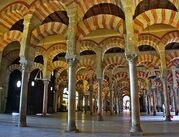
Forest of arches in the Mezquita de Córdoba
mosque. It is most famous for its forest of arches that resemble the Dome of the Rock's and its elaborate art and calligraphy on the walls. It was built by the Umayyad Moors upon the remains of an old Visigoth church and Pagan Roman temple as a mosque, and converted to a Catholic cathedral when the Christian armies reconquered Spain. Many elements of European architecture were added to the cathedral such as the choir room, but even Muslim travellers to Spain still praise the building's past as mosque. Muhammad Iqbal, a Pakistani poet who travelled to southern Spain in 1931. The famous Alhambra Palace (Arabic: الْحَمْرَاء) was built by Muhammad V, the sultan of Granada and Yusuf I, another prominent Muslim ruler at the time. It was built not only by the Umayyads, but other Muslim rulers as well and housed

Alcázar of Seville
various Muslim royal families. It is most famous for many elements, such as its courtyard, which is referred to as the Court of the Lions which contains a fountain of a lions that spewed water out of each mouth, surrounded by horse-shoe arches. The main hall contains an elabrote ceiling that is commonly referred to as the "Honeycomb" because of its appearance.

The honeycomb roof in the Alhambra Palace
As the Europeans armies reconquered the Iberian Peninsula, the building retained its parlimental uses, housing Spanish royal families. Similar structures known as alcázars (from the Arabic word meaning "fortress") can be found scattered all over Andalucia, in cities like Seville and Málaga and these structures tend to be complemented with a garden and a fountain.
Cuisine[]
Spanish cuisine is renowned for its use of fresh ingredients as well as the prestige winery skills. Many of these were inherited from the Romans. Seafood also dominates Spanish cuisine since Spain is surrounded by water.

Tortilla de Patatas
Staple ingredients include mostly seafood, pork, eggs and spices such as chili and vegetables such as cabbage, olives, onions and tomatoes. Cabbage is a vegetable that was consumed in the area known as Spain since the Roman era. Other considerable meats include lamb and beef. Rice is a staple grain in Spanish culinary traditions, it was the Spanish who brought rice to their overseas colonies. Paella is a rice-dish from the Valencia region of Spain. Paella usually includes vegetables, meats and seafood mixed in. Traditional Valencian paella is cooked over a fire, carried on a large plate (Valencians make it in high amounts) by several people. Tortilla de patata is a Spanish omelet with potatoes. The term literally translates to "potato omelet". Unlike usual omelets, Spanish tortillas are not folded, it is made by frying the egg batter and flipped to fry the other side. The potatoes, cheese, onions or any other ingredients are already
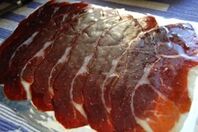
Jamón ibérico
included in the scrambled batter. Embutidos can come in any way or fashion. One typical type of embutido is botifarra from Catalonia. Spanish people typically from the region of Andalusia, eat a cold soup called gazpacho. Gazpacho contains raw vetgetables in a thick-tomato base soup. Spanish seafood dishes include merzula which is hake fish cooked Spanish style. Basque cuisine includes dishes such as marmitako which is spider crab. Basque people also use fishes like cod and tuna to make fillings inside piquillo peppers. Pork is the popular meat in Spanish cuisine. Lechón asado is typically one of Spain's most popular dishes. Lechón asado is a suckling pig delicacy, in which an entire suckling pig is roasted and many times, stuffed. This dish is also originated back to
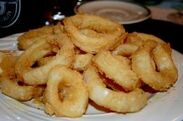
Calamares a la Romana
the Roman rule, and was usually only eaten by the upper-class people and the nobilities. Sausages and hams are also very popular in Spain and generally all of Europe. Spanish sausages are known as embutidos, which is a general term for Iberian style sausages. Chorizo is a smoked sausage, that can sometimes be sliced and eaten without being cooked. Longaniza is also a smoked sausage which resembles chorizo and is also eaten outside Spain, mostly Spain's former colonies in Latin America. Ham and sliced meats are also essential to Spanish culinary traditions. Tocino is a sweet bacon made from pork belly, which is known to be generally thick and fatty. Jamón ibérico is a cured ham that is produced exclusively in Spain (and Portugal), which is made from the black Iberian pig that lives mostly in southwestern Spain and southeastern Portugal. Due to the manner in which it is made and produced, jamón ibérico is not a
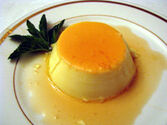
Flan
typical dish, and is a very expensive delicacy. It is not available widely either as other meats are. Typical seafood dishes include calamares a la romana which is a fried-squid dish. Pescaíto frito is a deep-fried fish dish from Andalusia. As popular as beef meat gets in Spain, the tongue is used to make a stew known as lengua estofada. Spanish desserts are usually made with dairy products and nougats. Turrón is a Spanish dessert made with honey, sugar, egg whites and almonds. Turrón can also made many different ways. Flan is a custard-dessert that resembles the French crème caramel. Polvorón is a sweet and crumble shortbread also produced in southern Spain. Wine is a central theme to Spanish-style desserts, as Spain is renowned worldwide for its fine and prestigious winery. During the Roman Empire-era,
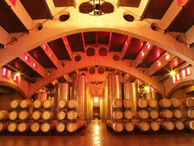
A wine cellar in Spain
wine was a delicacy only affordable by the upper classes and a noble drink for kings and queens. Wine is also used religiously in the Catholic church. Spain has been ranked as the third best and largest producer of quality wine, behind France and Italy. Spanish wine is mostly made with grapes, there are over hundreds of grape varieties in Spain, although only twenty of them are used. Vineyards are very common in Spain. In the towns of Jerez, Sanlúcar de Barrameda and El Puerto de Santa María, the Palomino grapes are used to make a type of wine known as sherry. Sherry can also be used as an ingredient for dishes. Cava is the Spanish variant of the French Champaigne, which is named after the place in France, therefore other countries are not permitted to use that name. Cava is made with the Xarel-lo grape. Other grapes used winery in Spain are Tempranillo, Albariño, Garnacha, Airen, Macabeo, Parellada, Cariñena and Monastrell grapes.
Notable Spaniards or People of Spanish Origin[]
|
Isabella I |
Also known by Isabella the Catholic, Queen of Castile and León who with her husband, Ferdinand II, united the Spanish kingdoms in the Iberian Peninsula into one polity and brought stability to the kingdom |
|
Ferdinand II |
King of Aragon who, by Isabella I's authority, became King of Castile and León and completed the Reconquista, one of the Catholic Monarchs he is also known as Ferdinand the Catholic |
|
Abd-ar-Rahman III |
The Ummayad Moorish ruler Córdoba, born to both Umayyad and Spanish nobilities who ruled for half a century, leading an influential reign marked by religious tolerance and became the most powerful Muslim ruler of Iberia |
|
Vasco Núñez de Balboa |
Spanish conquistador, explorer and governer who became the first European to reach the Pacific Ocean by using the New World as a starting point and found the first permanent European settlement in the Americas in 1510 in Panama |
|
Franciso Pizarro |
Spanish conquistador who conquered South America and governed it for Spain, he conquered the Incan Empire, he battled native forces with very few men without stopping by nearby Spanish outposts to refuel with ammunition |
|
Hernán Cortés |
Spanish conquistador who conquered Mexico and Central America and governed it for Spain, like Pizarro led one of the most dramatic conquests of the New World, he conquered the Aztec Empire |
|
Juan Ponce de León |
Spanish conquistador who discovered Florida and governed Puerto Rico for Spain, he led the first European exploration to Florida which was presumed to have the Fountain of Youth |
|
Miguel López de Legazpi |
Spanish conquistador who conquered Philippines and governed it for Spain, giving Spain its first Pacific territory |
|
Bartolomé de Las Casas |
Spanish priest who tried to save the Native Americans from Spanish persecution, "Savior of the Indians", argued for their rights as humans and allowed for peaceful conversions of the Native Americans to Roman Catholicism |
|
Ignatius of Loyola |
Founder of the Jesuit Movement, a Spanish knight from a local Basque noble family, hermit, priest since 1537, and theologian, who founded the Society of Jesus (Jesuits) and, on 19 April 1541, became its first Superior General. Ignatius emerged as a religious leader during the Counter-Reformation. Loyola's devotion to the Catholic Church was characterized by absolute obedience to the Pope. |
|
Alexander VI |
Head (pope) of the Catholic Church from 1492 to 1503, whose' papacy was known for libertinism and nepotism, his successors consider him to be one of the most successful popes ever since St. Peter and had the reputation of a skilled politician |
|
Francisco Goya |
A painter and artist from Aragon who did Romantic paintings for the crown and the royalty, he is regarded both as the last of the Old Masters and the first of the moderns. During the Peninsular War he remained in Madrid, where he painted the portrait of Joseph Bonaparte, pretender to the Spanish throne, and documented the war in the masterpiece of studied ambiguity known as the Desastres de la Guerra |
|
Pablo Picasso |
A painter from Spain who is known for his works on Cubism, lived in France for most of his life, Picasso, Henri Matisse and Marcel Duchamp are regarded as the three artists who most defined the revolutionary developments in the plastic arts in the opening decades of the 20th century, responsible for significant developments in painting, sculpture, printmaking and ceramics |
|
Salvador Dalí |
A prominent surrealist painter from the city of Figures in Spain, artist of the popular The Persistance of Memory |
|
Rosalía de Castro |
A prominent painter and poet from the region of Galicia, who wrote poems in the Galician language |
|
Penélope Cruz |
A Spanish actress known for her appearances in many films and television serie, Signed by an agent at age 15, she made her acting debut at 16 on television and her feature film debut the following year in Jamón, jamón (1992), to critical acclaim. Her subsequent roles in the 1990s and 2000s included Open Your Eyes (1997), The Hi-Lo Country (1999), The Girl of Your Dreams (2000) and Woman on Top (2000). Cruz achieved recognition for her lead roles in the 2001 films Vanilla Sky and Blow. She has modeled for companies such as Mango, Ralph Lauren and L'Oreal. |
|
Julio Iglesias |
A Spanish singer and songwriter, the top five artists in the world who has works in fourteen languages, also of Jewish origin through his mother's side |
|
Plácido Domingo |
Spanish conducter and tenor known for his strong voice, he is known for his versatile and strong voice, possessing a ringing and dramatic tone throughout its range. As of the end of 2013 he has sung 144 different roles. One of The Three Tenors, he has also taken on conducting opera and concert performances, and he is the general director of the Los Angeles Opera in California. |
|
Lilian Garcia |
A Spanish-American singer and songwriter best known for her singing roles in the World Wrestling Entertainment, during her first stint in WWE, she became the first WWE Diva to remain with the promotion for ten years |
|
Pau Gasol |
A Spanish professional basketball player who plays for the San Antonio Spurs of the National Basketball Association, he is a four-time All-Star, and a three-time All-NBA selection, once on the second team and twice on the third team. In the past, he has played for the Memphis Grizzlies and the Los Angeles Lakers. He was the 2002 NBA Rookie of the Year with the Grizzlies, and won two back-two-back NBA championships with the Lakers in 2009 and 2010. |
|
Rafael Nadal |
A tennis player from Spain who is voted as world no. 1 as of 2012, he has won 13 Grand Slam singles titles, the 2008 Olympic gold medal in singles, a record 26 ATP World Tour Masters 1000 and a record 14 ATP World Tour 500 tournaments. He was also a member of the winning Spain Davis Cup team in 2004, 2008, 2009, and 2011. In 2010, he became the seventh player in history and youngest of four in the Open Era to achieve the Career Grand Slam. He is only the second male player, after Andre Agassi, to complete the Career Golden Slam. |
Works Cited[]
- ↑ http://www.boe.es/boe/dias/2012/12/29/pdfs/BOE-A-2012-15714.pdf
- ↑ http://www.ine.es/prensa/np705.pdf
- ↑ http://www12.statcan.ca/census-recensement/2006/dp-pd/hlt/97-562/pages/page.cfm?Lang=E&Geo=PR&Code=01&Table=2&Data=Count&StartRec=1&Sort=3&Display=All&CSDFilter=5000
- ↑ http://www.ine.es/prensa/np705.pdf
- ↑ http://www.ine.es/prensa/np705.pdf
- ↑ name="INE Population Abroad 2012"
- ↑ http://www.ine.es/prensa/np705.pdf
- ↑ http://www.heritage-history.com/www/heritage.php?Dir=wars&FileName=wars_vandals.php
- ↑ http://www.spainthenandnow.com/spanish-history/visigoths-in-spain/default_154.aspx
- ↑ http://leonreal.es/?lang=en
- ↑ Roth, Norman (1994), Jews, Visigoths and Muslims in medieval Spain : cooperation and conflict, pp.79–90, Leiden: Brill, ISBN 978-90-04-09971-5
- ↑ "The Peninsular War" Britannica Encyclopedia. Retrieved 30-9-13
- ↑ http://modernhistorian.blogspot.com/2010/12/on-this-day-in-history-first-spanish.html
- ↑ http://www.donquijote.org/culture/spain/history/second-spanish-republic.asp
- ↑ http://www.britannica.com/EBchecked/topic/558032/Spanish-Civil-War
- ↑ Tremlett, Giles (2010-04-01). "Two arrested after fight in Cordoba's former mosque". The Guardian (London).
- ↑ Keeley, Graham (2010-04-03). "Muslims arrested for trying to pray in Cordobas former Mosque". The Times (London).
- ↑ "Roman City of Baelo Claudia". Spanishculture.com. Retrieved 10-10-2013.
- ↑ Rough Guide to Spain - Simon Baskett, 12th Edition, February 2007, Page 480

